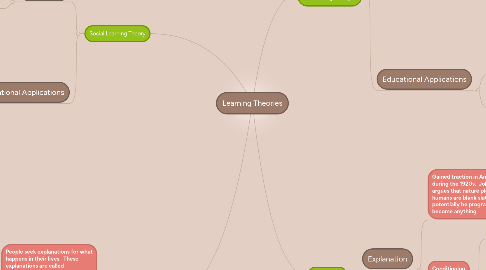
1. Attribution Theory
1.1. People seek explanations for what happens in their lives. These explanations are called attributions.
1.1.1. Three dimensions that categorize explanations.
1.1.1.1. Locus
1.1.1.1.1. External: Event occurs due to factors outside of the self
1.1.1.1.2. Internal: Event occurs as result of an action of the self
1.1.1.2. Controlability
1.1.1.2.1. Determines whether an occurs can be altered by the person in question.
1.1.1.3. Stability
1.1.1.3.1. Whether the occurrence will happen again consistently, or due to random chance.
1.1.1.4. Factors that affect attributions most significantly
1.1.1.4.1. Ability
1.1.1.4.2. Effort
1.1.1.4.3. Task Difficulty
1.1.1.4.4. Luck
1.2. Educational Applications
1.2.1. Teachers can try to reinforce factors that they feel are more beneficial for the student's learning. For instance, effort is deemed more useful and should be a repeated behavior. Related to Behaviorism, but different in that it deals with complex reasoning on the part of the human rather than simple emotional reactions.
2. Social Learning Theory
2.1. Explanation
2.1.1. Proposed by Albert Bandura
2.1.2. Raises issues with behaviorism
2.1.2.1. Argues that learners do not have to experience events or stimuli firsthand in order to adapt their beahvior
2.1.2.2. Imitation is a talent possessed by humans that enables them to mimic behaviors that yield positive consequences
2.1.2.3. Suggests that knowledge is acquired through observation
2.2. Educational Applications
2.2.1. Learners do not have to undergo cause and effect themselves/ Behavior can be modeled and subsequently imitated.
2.2.2. Educators can emphasize certain aspects of high-performing students to encourage lower-performing ones. A student's high level of effort, for instance, is a quality which should be held as an example.
3. Cognitive Information Processing Theory
3.1. Explanation
3.1.1. Product of Neobehaviorists; challenged weaknesses of Behaviorism
3.1.1.1. Simple emotional reactions and responses to external stimuli are not sufficient to explain human behavior. Another element is needed to explain human cognition.
3.1.2. Comparison of Human Mind to Computer
3.1.2.1. Similarities
3.1.2.1.1. Memory
3.1.2.2. Differences
3.1.2.2.1. Humans have a variety of Attributes that differentiate them from computers, including: purpose, values, emotions, and personality
3.1.2.2.2. Consciousness: humans are self-aware
3.2. Educational Applications
3.2.1. Workload: Teachers should be wary not to overload students' short-term memory
3.2.2. Schemata: Teachers should seek to build connections between new material and students' previous knowledge.
4. Behaviorism
4.1. Explanation
4.1.1. Gained traction in America during the 1920s. John B. Watson argues that nature plays no role, humans are blank slates that can potentially be programmed to become anything
4.1.2. Conditioning
4.1.2.1. Classical
4.1.2.1.1. Emotional responses, focusing on simple behavior.
4.1.2.2. Instrumental
4.1.2.2.1. Proposed by E.L. Thorndike
4.1.2.2.2. Focuses on more complex behavior
4.1.2.2.3. Random behavior can lead to a gradual alteration of a scope of actions
4.1.2.2.4. Law of Effect: behavior followed by rewards is more likely to be repeated.
4.1.2.3. Operant
4.1.2.3.1. Like other conditioning, uses stimulus and response, but also adds reinforcement.
4.1.3. Groundwork laid by Pavlov's dogs.
4.1.3.1. Humans respond to specific stimuli, which can be altered or conditioned, e.g dogs salivating when bell is rung.
4.2. Educational Applications
4.2.1. Reinforcement or the withholding of reinforcement is used to encourage certain behaviors.

